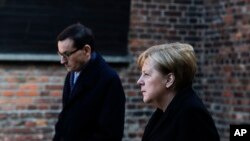German Chancellor Angela Merkel entered the hallowed grounds of the former Nazi German death camp of Auschwitz on Friday as she began her first ever visit to the most notorious site of the atrocities that Adolf Hitler's regime inflicted on Europe.
Merkel also brought a donation of 60 million Euros ($66.6 million). The money will go to a fund to conserve the physical remnants of the site - the barracks, watchtowers and personal items like shoes and suitcases of those killed.
Together, those objects endure as evidence of German atrocities and as one of the world's most recognizable symbols of humanity's capacity for evil. But they also are deteriorating under the strain of time and mass tourism, prompting a long-term conservation effort.
That donation to the Auschwitz Foundation comes in addition to 60 million euros that Germany donated when the fund was launched a decade ago, according to the Auschwitz-Birkenau state museum.
That brings the total German donation to 120 million euros and makes Germany by far the most generous of 38 countries that have contributed. As with the earlier donation, half comes from the federal government and half from the German states, an acknowledgement of the German nation's responsibility.
Since becoming chancellor in 2005, Merkel has paid her respects at other Nazi concentration camps, and she has been five times to Israel's Holocaust museum and memorial Yad Vashem.
Still, Poland's Foreign Ministry called her visit “historic,” in an obvious acknowledgement of the unique status Auschwitz has in the world's collective memory. The ministry also noted that it was just the third visit of an incumbent head of a German government.
Nazi German forces killed an estimated 1.1 million people at the Auschwitz-Birkenau complex during their occupation of Poland during World War II. Most of the victims were Jews transported from across Europe to be killed in gas chambers. But tens of thousands of others were killed there too, including Poles, Soviet prisoners of war and Roma, or Gypsies. The camp was liberated by the Soviet army on Jan. 27, 1945.
Germany's Merkel Begins Her First Ever Visit to Auschwitz






